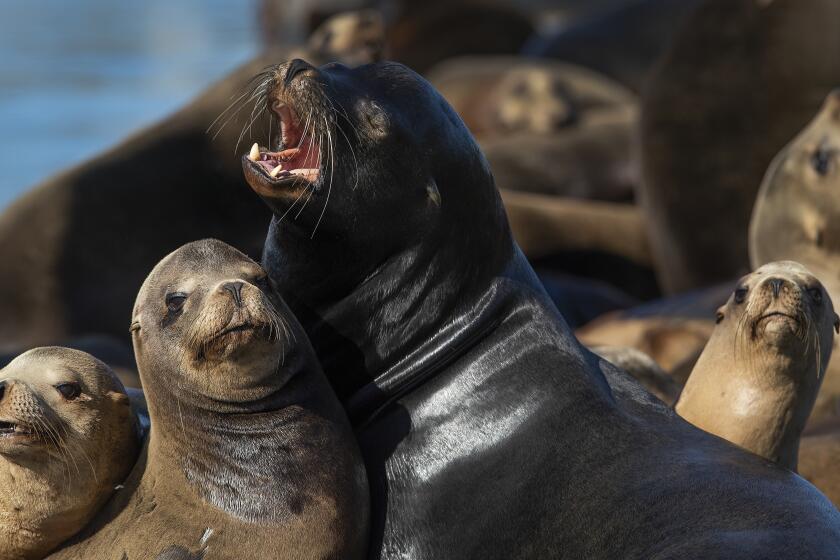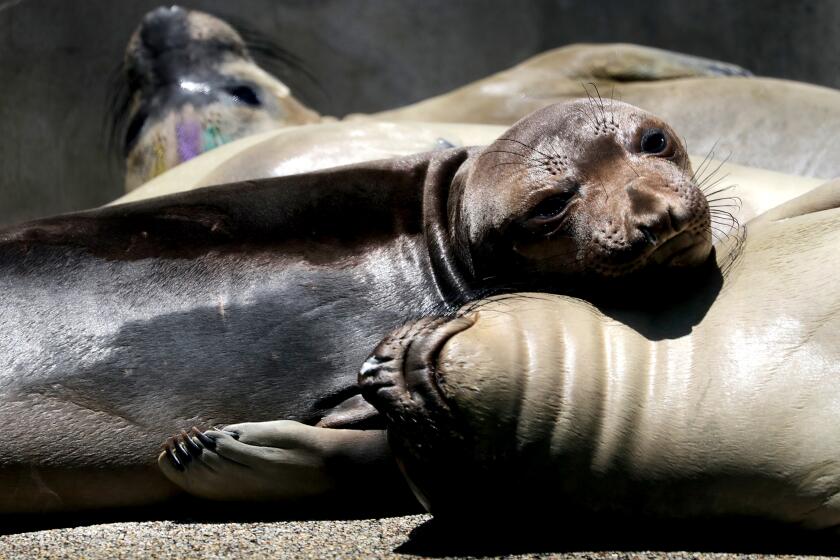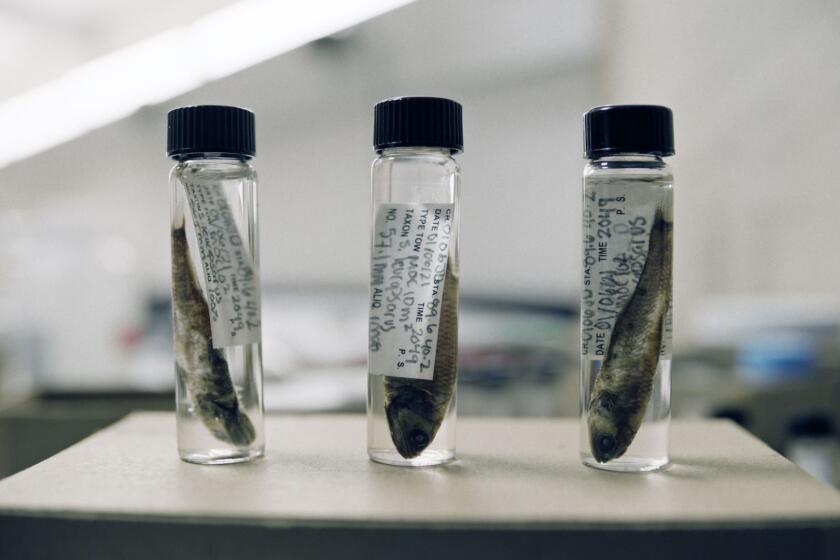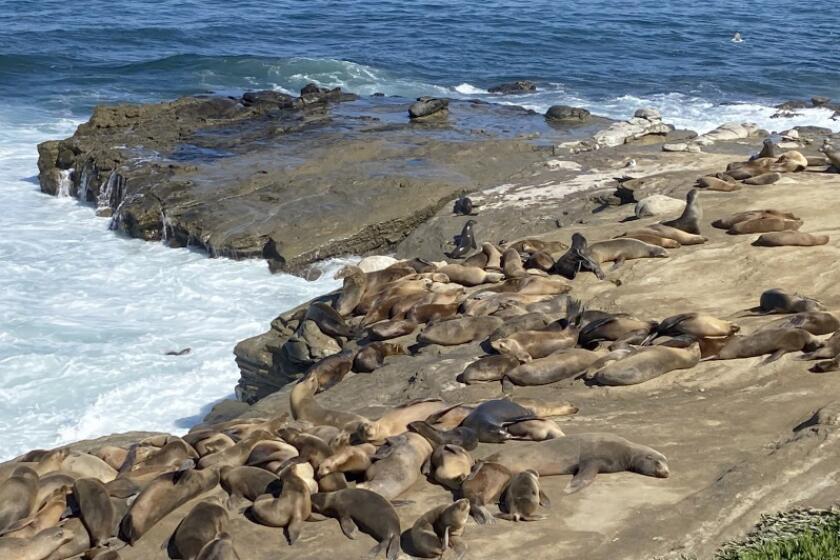‘Essentially a gas station,’ fishy feast draws sea lions to Pier 39 in numbers not seen in 15 years
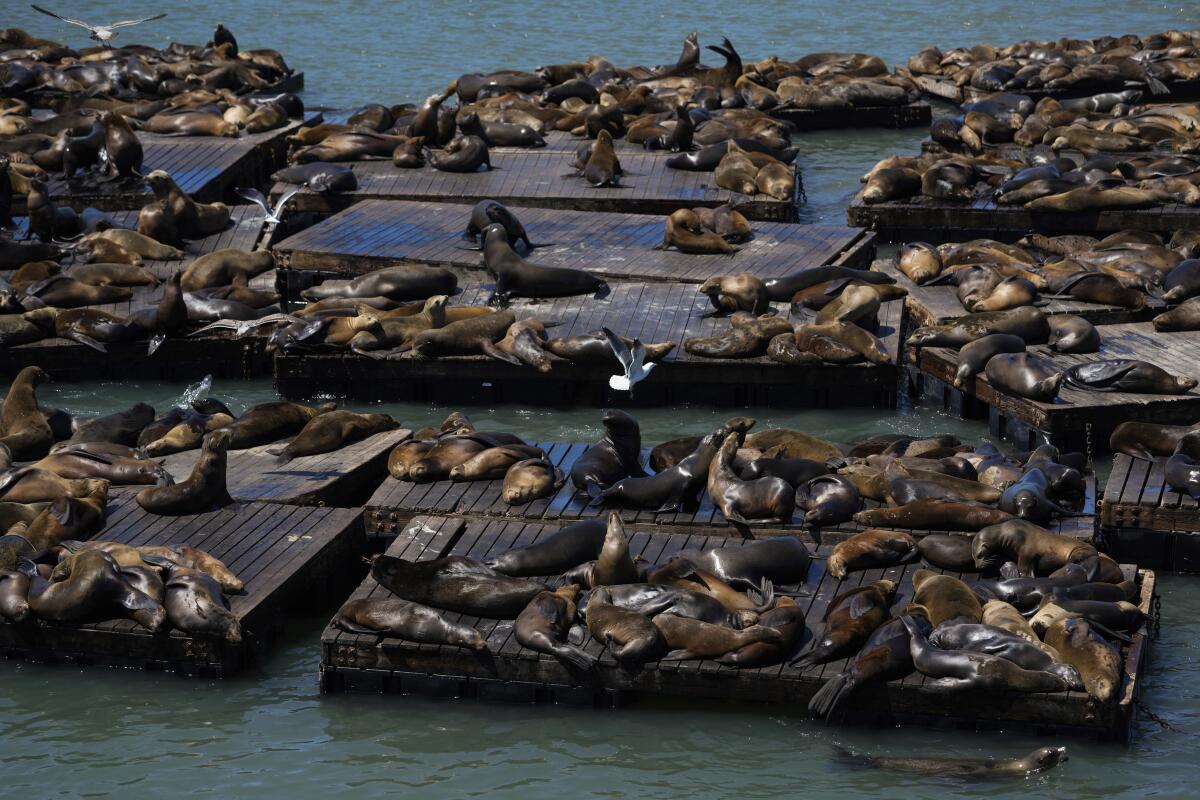
- Share via
They’re big, loud and smelly — and they have taken over San Francisco’s touristy Pier 39.
In recent days, some 1,100 to 1,200 anchovy-breathed, blubber-bodied sea lions have been counted flopping on and around the docks, Harbormaster Sheila Chandor said Tuesday. That’s the highest number recorded in 15 years.
The pinnipeds — which are cruising from as far north as southeastern Alaska down to the Channel Islands for mating season — have swarmed the pier in such large numbers because of a massive school of anchovies swimming near the Farallon Islands.
“There’s a feast going on out there right now,” Chandor said.
The welcome mat for California sea lions has been rolled out in San Francisco, but is nowhere to be seen in La Jolla and many of the state’s fishing ports.
The marine mammals, with their big eyes and long whiskers, have long been welcomed at Fisherman’s Wharf, where tourists can’t seem to get enough of them.
They first started hauling out at Pier 39 in 1989. Boats had been moved out of their slips while the docks were being remodeled, leaving lots of space for sea lions in search of a place to rest.
They started coming en masse after the San Francisco Bay Area was rocked that October by the Loma Prieta earthquake, which killed at least 63 people and caused more than $6 billion in damage. By January 1990, more than 150 sea lions swarmed the docks, drawing tourists who had avoided the area for months after the earthquake.
“The first showed up when we needed a boost, because we had just gone through the earthquake ... and we were dying on the vine, with no business,” said Chandor, who has worked at the pier since 1985. “It totally revitalized all the business on the wharf.”
More than 1,000 marine mammals along the Southern California coast have gotten sick or died because of the bloom of toxic algae, according to the National Oceanic and Atmospheric Administration.
The pier typically has a few hundred sea lions, with up to 700 or so in the spring, Chandor said.
The current, giant herd, which seems to be growing by the day, started showing up in late April, she said.
There have not been so many sea lions at the pier simultaneously since 2009, when more than 1,700 showed up, said Adam Ratner, director of conservation engagement at the Marine Mammal Center in Sausalito.
That year was “a big El Niño year, with a lot of changes in ocean health ... and a lot of fish right in that area, so it was kind of like the dinner bell ringing,” Ratner said.
Scientists have found DDT in zooplankton and deep-sea fish off the coast of L.A., indicating the toxic chemical might be infiltrating the base of the food web.
Ratner said Pier 39 has become “essentially a gas station” for migrating sea lions, where — safe from natural predators such as orcas and great white sharks — they can rest, sunbathe and fatten up before going down to the Channel Islands for some summer love.
“Sea lions go to Pier 39 for a lot of the same reasons people do: It’s a great place to rest and hang out, and there’s lots of good food around,” he said.
Ratner said the surge in healthy sea lions is, on the surface, a good sign for the animals’ population and the health of their habitat.
But it is hard to tell whether it’s a good indicator of the ocean’s overall ecological health, Ratner said.
“The deeper mystery is, why is that big school of fish out there?” he said. “Is it that there are more fish, which would be fantastic? Or maybe the fish have all congregated in one place, whereas they should be somewhere else.”
During the last sea lion surge in 2009, there was also a big school of anchovies off the bay — but food deserts for the sea lions elsewhere, Ratner said. Later that year, the pinnipeds, especially younger, smaller ones, struggled.
The San Diego City Council voted unanimously to temporarily close access to Point La Jolla year-round due to dangerous interactions with sea lions by members of the public.
Sea lions, he added, are like “sentinels of the sea,” providing clues about what is affecting the briny deep, such as toxins that sicken them and shifting fish populations that they chase.
Chandor said there seem to be other fish, not just anchovies, massing off the coast because harbor officials have seen upticks in dolphins and pelicans in recent weeks too.
The blubbery horde on Pier 39, she said, probably will clear out by early June, when “the call of the breeding season will call them away.”
Or, one would hope.
The “very vocal” sea lions are happy, well-fed and don’t seem to want to move much, Chandor said.
Usually, the floating rafts where they lounge and poop are power-washed weekly. But there have been so many sea lions in recent days that the cleaning has ceased because moving them “would just create mayhem,” Chandor said.
“It’s pretty stinky right now.”
More to Read
Sign up for Essential California
The most important California stories and recommendations in your inbox every morning.
You may occasionally receive promotional content from the Los Angeles Times.
